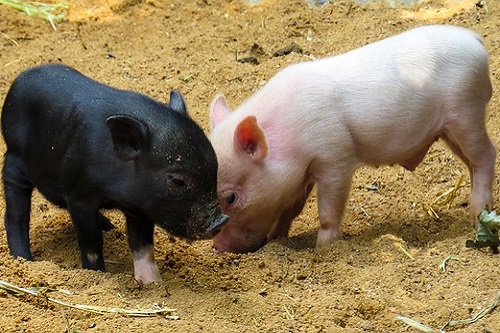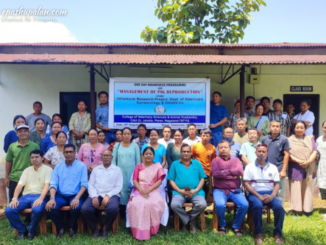Introduction
At every stage of the production cycle of pigs, abiotic stresses like heat stress and cold stress severely impairs efficiency. Heat stress is one of the largest economic barriers to the pork industry since pigs are mainly sensitive to heat stress because they lack functional sweat glands and in spite of decades of intense genetic selection and having a thick layer of subcutaneous adipose tissue that acts as an effective insulation layer. Over the past several decades, the swine industry has prioritised production efficiency and hence, has achieved rapid improvements in the lean growth and reproductive efficiency of pigs. The combination of climate change forecasts, increased pork production in tropical and subtropical regions of the globe, and improved genetic capacity for lean tissue accretion and fecundity, all point to increasing adverse impacts of heat stress on pork production efficiency and quality. Even though optimal heat/cold-stress abatement strategies were implemented by all pig producers, these stresses have been estimated to economically cost the swine industry annually through reduced/inconsistent growth, poor reproductive performances, increased mortality and morbidity, and decreased pork quality.
The focus of this article is current understanding of the physiological basis for compromised growth and reproduction in pigs as a result of heat stress and cold stress. Understanding of these essential developmental strategies to mitigate the deleterious effects of current and future climate change on the global swine industry.
Heat stress
Impacts on carcass composition and metabolism
Heat stress alters carcass composition. Traditionally, the detrimental effects of heat stress on production have been solely attributed to inadequate feed intake (reduced nutrient intake), highly conserved response which is an attempt to decrease metabolic heat production. But recent findings demonstrated that, production responses differ between thermos-neutral and heat-stress environments in both cattle and growing pigs even though given the same plane of nutrition. It is well known that pigs reared in heat-stress conditions have reduced muscle mass and increased adipose tissue. The metabolic shift occurred in heat-stressed animals is energetically interesting as animals under thermoneutral conditions consume a restricted diet will deposit protein at the expense of lipid accretion (i.e., the carcass lipid to protein ratio decreases meaning the carcass becomes leaner) and decreases the quantity of lipid deposited per unit of energy consumed. Hence, the relationship of reduced feed intake to body composition is exactly opposite in pigs reared in heat stress conditions and is independent of the plane of nutrition. Therefore, it is clear that heat stress alters the hierarchy of normal nutrient partitioning and is not conducive to profitable pig production.
Reduced basal plasma non-esterified fatty acid (NEFA) levels in heat-stressed animals despite marked reductions in feed intake, and especially when compared with that of thermoneutral controls. The lipolytic capacity of adipose tissue will be triggered as heat-stressed animals are severely under nutrient restriction, which is an energetic state typically associated with elevated circulating NEFA levels. Despite hallmarks usually related with hypoinsulinemia such as (1) marked reductions in feed intake, (2) negative energy balance and (3) rapid loss of body weight. The increase in insulin, a potent anabolic hormone, during heat stress, an intensely catabolic condition, is seemingly a biological paradox. In addition, glucose disposal also occurs quicker, and pigs will be more insulin sensitive during the heat stress. There increase in glucose utilisation from the whole-body occurs during heat stress. The immune system might be stimulated due to the deleterious effects of heat stress on intestinal health. Once activated, immune cells become obligate glucose utilisers, and this altered hierarchy of fuel requirements may trigger shift in body nutrient partitioning in order to spare glucose for the immune system. Adipose and muscle tissues become refractory to insulin whereas activated immune cells become insulin sensitive, and the immune system’s glucose utilisation may exceed that of systemic tissue.

Heat stress compromises intestinal health and reproduction
Heat-stress affects the gastrointestinal health. The small intestine is one of the first tissues upregulating heat shock proteins during a thermal load. During heat stress, blood flow is diverted from the viscera to the periphery in an attempt to dissipate heat, leading to intestinal hypoxia. Enterocytes are particularly sensitive to oxygen and nutrient restriction, resulting in ATP depletion and increased oxidative and nitrosative stress. This also contributes to tight junction dysfunction, and gross morphological changes that ultimately reduce intestinal barrier function. As a result, heat stress increases the passage of luminal content into the portal and systemic blood. LPS directly or indirectly increases pancreatic insulin secretion as infusing LPS into the mammary gland increased (~2-fold) circulating insulin in lactating animals.

Heat stress negatively impact the reproductive efficiency. Triggered hypothalamo pituitary adrenal axis resulting in altered endocrine functions and metabolic pathways for the maintenance of the body temperature make the animals to compromise their reproductive performances. Although the effects of heat stress on female pig reproduction are notable as increased ambient temperature lowering farrowing rates and is postulated to delay the onset of puberty. The impact of heat stress during oocyte maturation and early embryonic development is evidenced in the sows exposed to hyperthermia for 5 days following breeding. Heat stress has been associated with reduced developmental competence, and induction of apoptosis in in-vitro fertilised and parthenogenetically activated pig embryos. These verity of negative effects of heat stress during pregnancy in pigs appears to depend on the stage of gestation.
Boars also get affected negatively during heat stress, which can be explained primarily by poor semen production and quality. Semen from heat-stressed boars reported reduced the number and increased presence of abnormal sperm. Similar reports are reported even by the in-vitro studies. The ‘boar’ is obviously an important part of a successful summer reproductive management plan, and efforts to minimise the negative effects of heat stress on male fecundity and reproductive efficiency. ‘Seasonal infertility’ occurs due to high ambient temperature especially affecting the development of embryos as early-stage embryos are incredibly sensitive to increased body temperature. Early embryonic death, altered semen quality of boars and estrous cycles are the major reasons that affects the swine reproduction.
Cold stress
Pigs require more feed for the heat production and to maintain body condition. Growing pigs living in cold conditions are having poor feed conversion rates, increased feed intake, and likely struggle to grow without free access to good feed and warm housing. Depending on the age and size of pig, and outside temperatures and weather conditions, need to increase the daily feed allowance by 3x or more. Calories, energy to produce heat and stay alive, cannot realistically be met by simply increasing feed as the surrounding temperature decreases. Pigs are limited in their ability to eat massive amounts of calories in a given day. Essentially, when temperatures are too cold, and are persistent (lasting several days to weeks), pigs often find themselves in a negative energy balance that cannot be corrected with the feed alone. This leads to slowed or stunted growth of young pigs, and weight loss in the older pigs. In the most extreme cases, this can result in death. Cold stress creates a poor welfare situation for the pigs, as cold stress is an unnecessary burden, challenging their growth capacity, immune system, and even ability to live. This means ‘more feed for less meat’; in business terms, “greater input costs (feed, housing) and less return (price per pig for meat yield)”. This influences the importance of appropriate housing for pigs during the winter, as there is limited ability for a pig to meet is body heat needs through dietary means.
Strategies for swine to tolerate the heat and cold temperatures
- Physically modifying the environment is currently the primary abatement strategy that should be utilized to mitigate the negative effects of heat or cold stress, but other approaches include dietary modifications and genetic improvement.
- By providing cool, fresh, readily available drinking water for drinking. There are two main approaches for cooling using water. The most common is to sprinkle the animals with a sprinkler, misting or for lactating sows, a drip system. The second method is to increase the air water using a pad or high pressure fogging system. As the water evaporates, the air will get cooled. The main objective is, even though the animal is facing the heat stress, the animal’s heat balance is such that it ‘feels’ cooler which helps the pigs to continue normal feed intake and to maintain production.
- Avoid feeding the pigs during the hottest period of the day, as pigs are more likely to consume feed when it’s cooler. Feed small frequent meals to stimulate feed intake. Increase the fat content, reduce crude protein and assess the fiber quality of the diet.
- To support intestinal integrity and repair, feed additives such as butyric acid sources and anti-oxidants such a vitamin E and vitamin C, selenium and betaine can be incorporated in the feed. The dietary electrolyte balance should be taken care to correct electrolyte imbalances during periods of heat stress.
- Primarily, pigs should be offered shelter from precipitation and dampness. Water conducts heat. Humidity in the air will be drawn to pigs and will pull heat from them. Regardless of flooring type or usage of bedding material, provide pigs with a dry bedding area.
- Provide wind breaks and shelter from drafts. When providing shelter, be sure that your wind breaks do not allow air to draft around the space at pig level.
- Typical dietary management practices include formulating low thermic effect of feeding diets and this is primarily accomplished by increasing dietary fat and reducing the amount of crude protein or crude fiber during heat stress conditions.
- Insulate the pig area. This can take on a variety of forms, from bedding to insulated walls and ceilings. The idea is to capture as much heat as possible, while still allowing air exchange. More information on winter swine housing can be found in the Winter Housing for Swine Welfare article found on Penn State Extension’s website.
- Genetic selection for thermal tolerance is one potential strategy to mitigate the effects of heat stress, but this is a long-term solution, and typically accompanied by reduced productivity during thermal–neutral conditions.
- Strive to keep ambient temperatures within the thermoneutral (TN) zone of the pig, for age and body size. The thermoneutral zone for most mammals varies with age and body weight. For suckling and young growing pigs, this is particularly important as they lack significant sources of adipose (fat) at birth, and do not develop these stores until maturity. This lack of fat prevents them from having any energy reserves to burn for maintaining body heat.






Be the first to comment